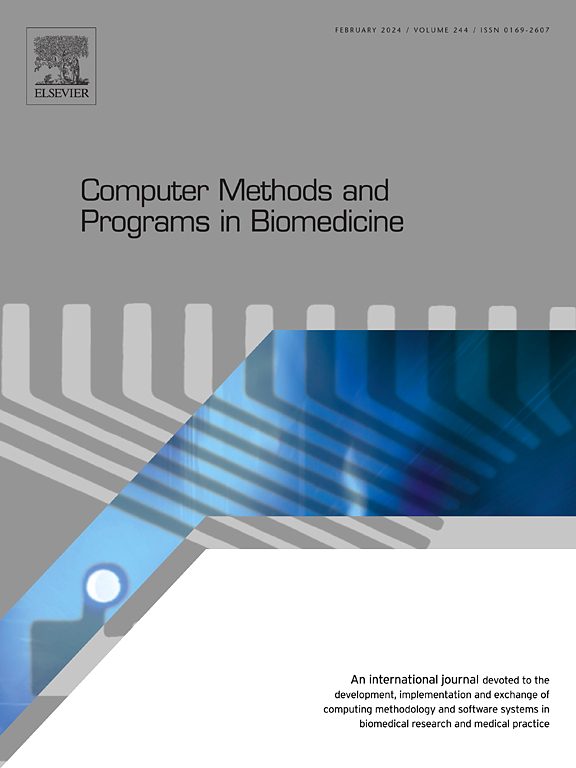空间转录组学揭示了肺腺癌微环境的区域异质性和亚克隆动力学
IF 4.8
2区 医学
Q1 COMPUTER SCIENCE, INTERDISCIPLINARY APPLICATIONS
引用次数: 0
摘要
背景与目的肺腺癌具有较高的发病率和死亡率。虽然单细胞转录组学揭示了肿瘤细胞的异质性,但它缺乏空间细节,使得空间动力学和功能异质性在很大程度上未被探索。本研究旨在利用空间转录组学提供肺腺癌的全面细胞景观,解决单细胞分析的局限性。方法利用细胞类型特异性标记和单细胞转录组学分析获得的空间转录组学数据,进行细胞反褶积,评估组织偏好,构建轨迹,分析点-点相互作用,以创建肺腺癌的综合细胞景观。我们对来自单细胞转录组学的125,203个单细胞进行了无监督降维聚类,并利用这些数据对单独分析的空间转录组学样本中3990个斑点的细胞组成进行了反卷积。通过构建从肿瘤外围到核心的轨迹,我们发现与氧水平反应相关的通路显著上调,而免疫反应通路明显下调。伪时间分析发现成纤维细胞区域与肿瘤密切相关,邻近肿瘤区域表现出强烈的上皮-间质转化和肿瘤迁移特征,定义为肿瘤侵袭方向。在肿瘤区域内进一步降维聚类可划分为6个亚组,每个亚组均表现出显著的空间和功能异质性。值得注意的是,Ca_0亚组与肿瘤侵袭过程密切相关,而Ca_1亚组与不良预后显著相关。相互作用分析表明,Ca_1亚群可能通过促进血管生成和免疫逃逸来促进肿瘤的整体进展,而不是直接参与肿瘤的侵袭。结论本研究深入分析了肺腺癌及其微环境的空间功能异质性,揭示了肿瘤微环境中具有显著空间和功能多样性的4个功能异质性群体。该研究还确定了与肿瘤侵袭和进展密切相关的关键区域和基因表达变化,突出了肿瘤动力学的关键方面。本文章由计算机程序翻译,如有差异,请以英文原文为准。
Spatial Transcriptomics Unveils Regional Heterogeneity and Subclonal Dynamics in the Lung Adenocarcinoma Microenvironment
Background and Objective
Lung adenocarcinoma has high incidence and mortality rates. While single-cell transcriptomics reveals tumor cell heterogeneity, it lacks spatial detail, leaving the spatial dynamics and functional heterogeneity largely unexplored. This study aims to utilize spatial transcriptomics to provide a comprehensive cellular landscape of lung adenocarcinoma, addressing the limitations of single-cell analysis.
Methods
Utilizing cell type-specific markers and spatial transcriptomics data derived from single-cell transcriptomic analysis, we performed cell deconvolution, assessed tissue preferences, constructed trajectories, and analyzed spot-spot interactions to create a comprehensive cellular landscape of lung adenocarcinoma.
Results
We conducted unsupervised dimensionality reduction clustering on 125,203 single cells from single-cell transcriptomics, and used this data to deconvolute the cellular composition of each of the 3990 spots in a separately analyzed spatial transcriptomics sample. By constructing a trajectory from the tumor's periphery to its core, we discovered that pathways related to oxygen level responses were significantly upregulated, while immune response pathways were notably downregulated. Pseudotime analysis identified fibroblast areas closely associated with the tumor, with neighboring tumor areas exhibiting strong epithelial-mesenchymal transition and tumor migration characteristics, defined as the direction of tumor invasion. Further dimensionality reduction clustering within the tumor area differentiated six subgroups, each showing significant spatial and functional heterogeneity. Notably, the Ca_0 subgroup is closely linked to the tumor invasion process, whereas the Ca_1 subgroup is significantly associated with poor prognosis. Interaction analysis suggests that the Ca_1 subgroup may facilitate overall tumor progression by promoting angiogenesis and immune escape, rather than by directly participating in tumor invasion.
Conclusions
This study provides an in-depth analysis of the spatial-functional heterogeneity in lung adenocarcinoma and its microenvironment, revealing four functionally heterogeneous groups with significant spatial and functional diversity within the tumor microenvironment. The study also identifies key areas and gene expression changes closely associated with tumor invasion and progression, highlighting critical aspects of tumor dynamics.
求助全文
通过发布文献求助,成功后即可免费获取论文全文。
去求助
来源期刊

Computer methods and programs in biomedicine
工程技术-工程:生物医学
CiteScore
12.30
自引率
6.60%
发文量
601
审稿时长
135 days
期刊介绍:
To encourage the development of formal computing methods, and their application in biomedical research and medical practice, by illustration of fundamental principles in biomedical informatics research; to stimulate basic research into application software design; to report the state of research of biomedical information processing projects; to report new computer methodologies applied in biomedical areas; the eventual distribution of demonstrable software to avoid duplication of effort; to provide a forum for discussion and improvement of existing software; to optimize contact between national organizations and regional user groups by promoting an international exchange of information on formal methods, standards and software in biomedicine.
Computer Methods and Programs in Biomedicine covers computing methodology and software systems derived from computing science for implementation in all aspects of biomedical research and medical practice. It is designed to serve: biochemists; biologists; geneticists; immunologists; neuroscientists; pharmacologists; toxicologists; clinicians; epidemiologists; psychiatrists; psychologists; cardiologists; chemists; (radio)physicists; computer scientists; programmers and systems analysts; biomedical, clinical, electrical and other engineers; teachers of medical informatics and users of educational software.
 求助内容:
求助内容: 应助结果提醒方式:
应助结果提醒方式:


